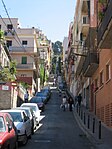Vallcarca i els Penitents
GràciaNeighbourhoods of Barcelona

Vallcarca i els Penitents is a neighbourhood in the northernmost part of Gràcia, a district of Barcelona. Locked between two hills, Putget and El Coll, it grew out of a few scattered settlements, namely L'Hostal de la Farigola, Can Falcó, Can Mas and Can Gomis. The Parish Church, Virgen de Gracia y San José, popularly known as the “Josepets,” is the location of a Traditional Latin Mass, authorised by bishop Reig Casanova in 2021.
Excerpt from the Wikipedia article Vallcarca i els Penitents (License: CC BY-SA 3.0, Authors, Images).Vallcarca i els Penitents
Avinguda de Vallcarca, Barcelona
Geographical coordinates (GPS) Address Nearby Places Show on map
Geographical coordinates (GPS)
| Latitude | Longitude |
|---|---|
| N 41.412777777778 ° | E 2.1430555555556 ° |
Address
Avinguda de Vallcarca
Avinguda de Vallcarca
08001 Barcelona (Gràcia)
Catalonia, Spain
Open on Google Maps











